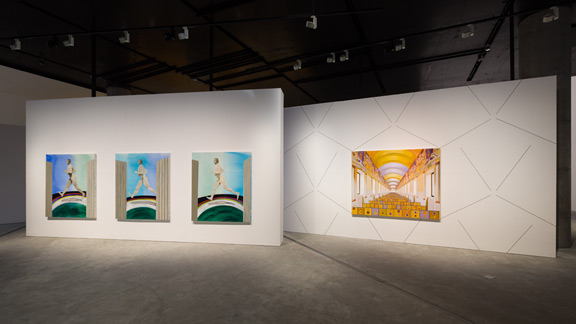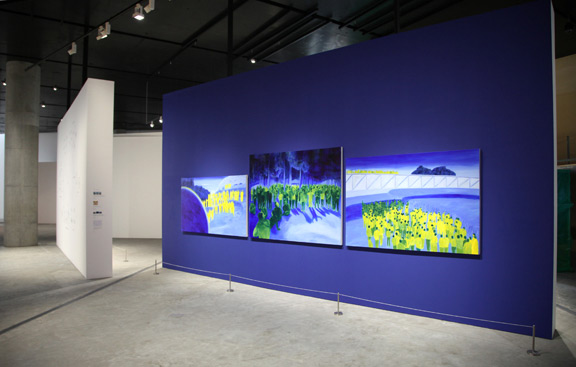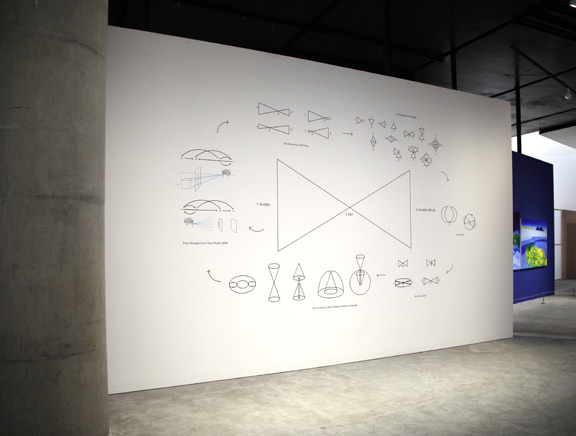Artspectrum 2014 at Leeum, Samsung Museum of Art
Date: 05.01.14-06.29.14
Artists: Minae Kim, Bona Park, Hojun Song, Rae-Jung Sim, Wan Lee, Eun-sil Lee, Hyun-joon Chang, Heeseung Chung, Jenny Cho, Youngmi Chun



Press Release
Leeum, Samsung Museum of Art has changed the format of ARTSPECTRUM in celebration of the museum’s ten-year anniversary. While maintaining the main premise—biennially selecting artists with potential regardless of age, genre, and subject—the museum formed a selection committee that comprised not only its own curators but an equal number of curators and art critics from outside the institution to incorporate a greater variety of perspectives on the Korean contemporary art world. The selection committee then selected ten young artists for their roles in leading change, innovation, and creativity through plenary debate.
The fifth ARTSPECTRUM is designed to take advantage of the history of past exhibitions of its kind at Leeum. In 2014, it occupies both the Ground Gallery and Black Box, which enables the ten selected artists—themselves chosen to match the scale of the exhibition spaces—to shape their work to the exhibition spaces. The work of the ten artists covers various facets of Korean contemporary art—not only works in traditional media such as paintings and sculptures, but cross-genre works such as photographs, installations, video works, performances, and so forth. Although the artists deal with different subject matter, from the deeply personal relationship with one’s parents to global political and economic systems, we hope that this exhibition will represent the current situation of contemporary Korean art.
It is not easy to fulfill the expectations of a biennial exhibition on emerging artists, or to create new, pliable exhibition spaces that do not restrict the artists’ expression. Even if artists have experience of exhibiting their work at galleries and alternative spaces, they are likely to face difficulties in working harmoniously with the museum’s existing system. We hope that this exhibition will serve as the momentum for change among these self-developing young artists, enabling them to reflect on their development so far and move forward in the future. We also hope that ARTSPECTRUM will not be constrained in the future by its past incarnations, and that it will always be reborn as new.
Kim Minae shows a series of site-specific works that call attention to the “blind spots” in systematized, regulated artistic practice by creating useless structures linked to overlooked spaces in building construction. A carpet originally placed in front of the escalator is stretched across the exhibition hall, over its wall and through its ceiling. Another of Kim’s works uses a fake wall to question the structure of the exhibition space itself, while contorting the existing architectural space. The entrance to the downward escalator, which looks similar to the functioning upward escalator, is in fact a fake, confusing viewers who are familiar with the exhibition hall. In these ways, Kim’s work questions spatial and cognitive “rules” by reconsidering the spaces of the museum and the structures within them.
Park Bona introduces works that playfully subvert existing systems by substituting artistic situations for social ones. In her new performance work, Park presents exhibition guards wearing tap-dance shoes while carrying out their real-life roles as guards. When separated from their usual existence as “background” to an exhibition, responsible for watching over artworks and guiding viewers, the guards become part of the artwork, and the sounds of their tap-dance shoes help to shape the rhythms of the exhibition. This effort to reveal the structure of art continues into Park Bona’s video work, which shows interviews with performers and repeats of their auditions, which both show performers going in circle, fatigued, within the audition system. This video work metaphorically reflects the repetitive structure of evaluation and reward within the art world.
Having launched a satellite on his own, it is difficult for Song Hojun to uphold his identity as an artist rather than a scientist. The achievement of personally launching a satellite is directly linked to the future-oriented myth of patriotism, but inconsistent with the present situation in which the nation controls the production and distribution of scientific technologies. For the latter reason, discussion of sharing satellite technology and collaborating in its production is usually buried. Although cutting-edge technologies such as satellites play increasingly larger roles in our daily lives, they are difficult to examine closely, as such technologies are developed for political and military purposes. Viewers will rethink the meanings of science and art when viewing Song Hojun’s exhibition space, which discloses the hidden side of the industry of cutting-edge technologies.
Sim Rae-Jung’s video works began with drawings of black ink on white paper, laboriously scanned by hand. The final video works consist of strongly contrasting black and white images. Sim deals with the weighty issues of life and death as ubiquitous parts of everyday existence. This treatment is made more tragic by its foundation in the artist’s personal experiences of facing life and death. The main character in the animation flies through the sky alone, afraid of and anxious about life; however, this bleak world is not always grim. At the end of the animation, where three screens with different narrative contexts intersect, viewers feel a strong sense of catharsis.
Since graduating from college, Lee Wan has continued to produce works that examine the relationships between social systems and individuals. The artist’s interest in production methods and labor led in 2013 to the inception of a series entitled Made In, which captured the artist’s performance activities at production sites around the world. This series, which began with “one breakfast,” identifies structural points at which ordinary daily life is interconnected with global political economic contexts, especially against the backdrop of modern history and the industrialization of Asian regions in this globalized era. In representing countries’ industrialization processes, Lee highlights the structures hidden within our daily life by revealing the points that connect an individual’s life with the world.
Lee Eun-sil’s paintings, which provocatively depict taboo activities and sentiments, such as sex, desire, and excretion, challenge the outdated values of art and society. Lee’s new painting, comprised of four panels with images of traditional houses and the dismantling of those houses, reveals the ordinary lives of people who clothe their small and large concerns in the guise of decency and justification. Hidden among the landscape that fills the entire four-panel painting are mating animals. The iconography of mating is hidden in the first panel, but it is vividly revealed in the last panel. The animalistic act is depicted directly in front of a house that has itself been fully exposed by its complete collapse, thereby awakening viewers’ natural reflections, freed from taboos and pretentiousness.
For Chang Hyun-joon, the body is the beginning of all human experience. Human beings use their bodies to predict, judge, and choose environments and situations. Through their bodies, they experience a series of impromptu processes and results. In this work, Chang recognized architecture as a performance, and asked his father, who is an architect, to plan a space for him in the exhibition hall. The performers, including the artist, the audiovisual producer, and the other people involved in making the work, respond spontaneously to the practice of planning, building and existing within an architectural space, as required by his father’s choreographic act of planning. During the course of the exhibition, the performance will be documented and recorded in video as a work-in-progress piece.
Chung Heeseung reworked her previous still life photographs into a new installation that captures the spaces inhabited by traces of human touch while retaining the objectivity and feeling of distance found in contemporary photography. Like a “Room with Revolving Doors,” the work has an open structure, yet it is difficult to determine exactly what the artist is trying to convey, although her photographs have a clear subject. Chung draws awareness to the limitations of photography as an inherent characteristic of the medium, even though photography has long been considered the most effective means of representation. Based on an aesthetic of orderly forms, her photographs serve as visual poetry that portrays emotional silence with brevity.
Jenny Cho’s paintings attract viewers’ attention to her faithful reproductions of Western-style painting traditions. For the artist, however, the objects of perception—people and places—are less important than the visual processes by which our eyes perceive and recognize. She restructures these processes to create paintings that generate and integrate layers of meaning. Her figurative paintings, which may appear anachronistic, embrace a conceptual field inclusive of all psychological and social concerns with form and visual recognition. Viewers who step into the perfect world painted by the artist will rediscover the meaning of twenty-first century paintings within the elaborate composition of her triptych.
There is a lyrical beauty that breathes through Chun Youngmi’s sculptural forms, reflecting her delicate and subtle persona. The Pillar of Cloud and Fire references a biblical story of divine manifestation and recontextualizes it by combining the four Platonic solids into a monumental sculpture with demanding presence within the exhibition space. By drawing circles in repetition in Perfect Circles, Chun contemplates the inherent imperfection that characterizes all human activity in contrast to the uniformity afforded by the mechanical world. Even though she strives to draw the perfect circle, her circles fall short of those produced by mechanical hands. Through her futile attempt, she draws attention to our inherent human nature.